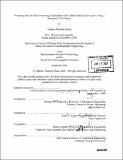Emulating the fast-start swimming performance of the Chain Pickerel (Esox niger) using a mechanical fish design
Author(s)
Watts, Matthew Nicholas
DownloadFull printable version (6.400Mb)
Other Contributors
Woods Hole Oceanographic Institution.
Advisor
Michael S. Triantafyllou and Franz S. Hover.
Terms of use
Metadata
Show full item recordAbstract
Mean maximum start-up accelerations and velocities achieved by the fast-start specialist, northern pike, are reported at 120 ms-2 and 4 ms-1, respectively (Harper and Blake, 1990). In this thesis, a simple mechanical system was created to closely mimic the startle response that produces these extreme acceleration events. The system consisted of a thin metal beam covered by a urethane rubber fish body. The mechanical fish was held in curvature by a restraining line and released by a pneumatic cutting mechanism. The potential energy in the beam was transferred into the fluid, thereby accelerating the fish. The fish motion was recorded and the kinematics analyzed while using a number of different tail shapes and materials. Performance of the mechanical fish was determined by maximum acceleration, peak and averaged maximum velocity, and hydrodynamic efficiency. Maximum start-up acceleration was calculated at 48 ms-2. Peak and averaged maximum velocity was calculated at 0.96 ms-1 and 0.8 ms-1, respectively. The hydrodynamic efficiency of the fish, calculated by the transfer of energy, was 11%. Flow visualization of the mechanical fast-start wake was also analyzed. The visualization uncovered two specific vortex-shedding patterns; a single and a double-vortex pattern are described.
Description
Thesis (S.M. in Oceanographic Engineering)--Joint Program in Ocean Engineering/Applied Ocean Physics and Engineering (Massachusetts Institute of Technology, Dept. of Mechanical Engineering; and the Woods Hole Oceanographic Institution), 2006. Includes bibliographical references (p. 74-75).
Date issued
2006Department
Joint Program in Ocean Engineering/Applied Ocean Physics and Engineering; Woods Hole Oceanographic Institution; Massachusetts Institute of Technology. Department of Mechanical EngineeringPublisher
Massachusetts Institute of Technology
Keywords
Joint Program in Ocean Engineering/Applied Ocean Physics and Engineering., Mechanical Engineering., Woods Hole Oceanographic Institution.